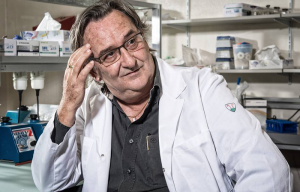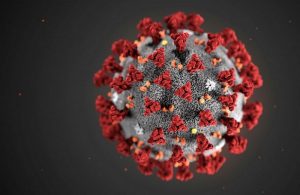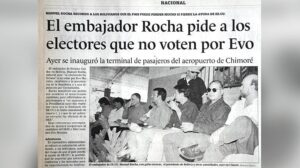El SIDA NO ES UNA ENFERMEDAD INFECCIOSA -Bibliografía
Referencias Bibliograficas
United States, Centers for Disease Control and Prevention (CDC). The HIV/AIDS pandemic, 2006. http://www.cdc.gov/mmwr/preview/mmwrhtml/mm5531al.htm?s_cid=mm5531a1_e Roberts L, Cohen J. HIV/AIDS: Latin America & Caribbean. Science July 28, 2006; 313: 467-490. De Harven E. Pioneer deplores “HIV” “maintaining errors is evil” Continuum (London) 1997-1998; 5(2): 24. Duesberg PH. Retroviruses as carcinogens and pathogens: Expectations and reality. Cancer Research 1987; 47: 1199- 1220. Duesberg PH. Human immunodeficiency virus and acquired immunodeficiency syndrome: Correlation but no causation. Proc Natl Acad Sci USA 1989; 86: 755-764. Duesberg PH. AIDS Epidemiology: Inconsistencies with HIV and with infectious diseases. Proc Natl Acad Sci USA 1991; 88: 1575-1579. Duesberg PH. AIDS acquired by drug consumption and other noncontagious risk factors. Pharmac Ther 1992; 55:201-277. Duesberg PH. Can epidemiology determine whether drugs or HIV cause AIDS? AIDS-Forschung 1993; 12: 627-635. Duesberg PH. Foreign-protein-mediated immunodeficiency in hemophiliacs with and without HIV. Genetica 1995; 95: 51-70. Duesberg PH. Inventing the AIDS virus. Washington DC: Regnery Publishing Inc. 1996; 722. Duesberg PH, Rasnick D. The drug-AIDS hypothesis. Continuum (London) 1997; 4(5); S1-S24. Duesberg PH, Rasnick D. The AIDS dilema. Drug diseases blamed on a passenger virus. Genetica 1998; 104: 85-132. Duesberg PH, Koehnlein C, Rasnick D. The chemical bases of the various AIDS epidemics: recreational drugs, anti-viral chemotherapy and malnutrition J. Biosci. 2003; 28: 383–412. Papadopulos-Eleopulos E. Reappraisal of AIDS – Is the oxidation induced by the risk factors the primary cause? Medical Hypothesis 1988; 25: 151-162. Papadopulos-Eleopulos E, Turner VF, Papadimitriou JM, Causer D. A critical analysis of the HIV-T4-cell AIDS hypothesis. Genetica 1995; 95: 5-24. Giraldo RA. AIDS and stressors I: Worldwide rise of immunological stressors (Abstract). Toxicology Letters Supplement 1/78. 1995: s34. Giraldo RA. AIDS and stressors II: A proposal for the pathogenesis of AIDS (Abstract). Toxicology Letters Supplement 1/78. 1995: s34. Giraldo RA. AIDS and stressors III: A proposal for the natural history of AIDS (Abstract). Toxicology Letters Supplement 1/78. 1995: s35. Giraldo RA. AIDS and stressors IV: The real meaning of HIV (Abstract). Toxicology Letters Supplement 1/78. 1995: s35. Los resumenes de SIDA y estresantes I, II, III y IV se encuentran publicados en español en “El Pequeño Periódico“, publicación de la Fundación Arte y Ciencia, Medellín, Colombia, Marzo de 1996 (46); p. 8-10. Giraldo RA. Polemica científica internacional acerca de la causa del SIDA. Investigación y Educación en Enfermería (Universidad de Antioquia, Facultad de Enfermería, Colombia) 1996; 14(2); 55-74. Giraldo RA. Papel de estresantes inmunológicos en la inmunodeficiencia. IATREIA (Universidad de Antioquia, Facultad de Medicina, Colombia) 1997; 10: 62-76. Giraldo RA. AIDS and stressors: AIDS in neither an infectious disease nor is sexually transmitted. It is a toxic-nutritional syndrome caused by the alarming worldwide increment of immunological stressor agents. Medellín, Colombia: Impresos Begón; 1997; 205. Giraldo RA. El alarmante incremento mundial de agentes estresantes inmunológicos. En: Ahumada C, Hernandez A, Velasco M. Relaciones internacionakles, política social y salud: Desafios en la era de la globalización. Bogotá: Fundación Cultural Javeriana de Artes Gráficas. 1998; 49-73. Giraldo RA. Es un virus la verdadera causa del SIDA? Los agentes estresantes inmunologicos podrían ser la verdadera causa del SIDA. Natura Medicatrix 2002; 20: 208-313. Smith DK, Neal JJ, SD, CDC. Idiopathic CD4 T-lymphocytopenia task force. Unexplained opportunistic infections and CD4 T-lymphocytopenia. NEJM 1993; 328: 373-379. Ho DD et al. Idiopathic CD4 T-lymphocytopenia – Immunodeficiency without evidence of HIV infection. NEJM 1993; 328: 380-385. Duncan RA et al. Idiopathic CD4 T-lymphocytopenia – Four patients with opportunistic infections and no evidence of HIV infection. NEJM 1993; 328: 393-398. Fauci CD4 T-lymphocytopenia without HIV infection – No lights, no camara, just facts. NEJM 1993b; 328: 429-431. Altman LK. “Long term survivors may hold key clues to puzzle of AIDS”. The New York Times. Science Times, enero 24 1995, p. C1 y C11. Baltimore D. Lessons from people with nonprogressive HIV infection. NEJM 1995; 332: 259-260. Levy JA. Overall features of HIV pathogenesis: Prognosis for long-term survival. En: HIV and the pathogenesis of AIDS. Second Edition. Washington DC: ASM Press; 1998; 311-338. Layon J et al. Altered T-lymphocyte subsets in hospitalized intravenous drug abusers. Arch Intern Med 1984; 144: 1376. Goedert JJ et al Decreased helper T lymphocytes in homosexual men. II. Sexual practices. Amer J Epidemiol 1985; 121: 637-644. Des Jarlais et al. CD4 Lymphocytopenia among injecting drug users in New York City. J AIDS 1993; 6: 820-822. Marion SA et al. Evidence that prior immune dysfunction predisposes to human immunodeficiency virus infection in homosexual men. J AIDS 1989; 2: 178-186. Papadopulos-Eleopulos E, Turner V, Papadimitriou JM. Is a positive Western blot proof of HIV infection ? Bio/Technology 1993; 11: 696-707. Papadopulos-Eleopulos E, Turner VF, Papadimitriou JM, Causer D. The isolation of HIV: Has it really been achieved? The case against. Continuum (London) September/October 1996; 4(3); S1-S24. Papadopulos-Eleopulos E, Turner V, Papadimitriou JM, Causer D. HIV antibodies: Further questions and a plea for clarification. Curr Med Res Opin 1997; 13: 627-634. Papadopulos-Eleopulos E, Turner V, Papadfimitriou J et al. A critique of the Montagnier evidence for the HIV/AIDFS hypothesis. Aceptado para ser publicado en Medical Hypothesis en 2004. Puede leerse enwww.theperthgroup.com/SCIPAPERS/MHMONT.pdf De Harven E. Remarks on methods for retroviral isolation. Continuum (London) 1998; 5(3); 20-21. Giraldo RA, de Harven E. HIV tests cannot diagnose HIV infection. Abril de 2006. www.robertogiraldo.com/eng/papers/Farber_Reply_April_2006.htm Fauci Immunopathogenesis of HIV infection. J Acq Immunodeficiency Syndromes 1993: 6: 655-662. Levy JA. Pathogenesis of human immunodeficiency virus infection. Microbiological Reviews 1993; 57: 183-289. Darrow WW, Jaffe HW, Curran JW. Passive anal intercourse as a risk factor for AIDS in homosexual men. Lancet 1983; ii: 160. James K, Hargreave E. Immunosuppression by seminal plasma and its possible clinical significance. Immunol today 1984; 5: 357. Root-Bernstein RS, Hobbs De Witt S. Semen Alloantigens and Lymphocytotoxic Antibodies in AIDS and ICL. Genetica 1995; 95: 133-156. Holsapple MP, Munson AE, Amos H. Immunotoxicology of abused drugs. En: Dean JH, Luster MI, Munson AE, Amos H. Immunotoxicology and immunopharmacology. New York: Raven Press; 1986; 381. Friedman H, Klein TW, Specter S. Immunosuppression by marihuana and its components. En: Ader R, Felten DL, Cohen N. Psychoneuroimmunology. San Diego: Academic Press; 1991; 931-953. Bryant HU, Cunningham KA, Jerrells TR. Effects of cocaine and other drugs of abuse on immune responses. En: Lakoski JM, Galloway MP, Whithe FJ. Cocaine: Pharmacology, physiology, and clinical strategies. Boca Raton: CRC Press; 1992: 353-369. Kaminski NE. Mechanism of immune modulation by cannabinoids. En: Dean JH, Luster MI, Munson AE, Kimber Immunotoxicology and immunopharmacology. New York: Raven Press; 1994; 349-362. Friedman H, Bendinelli M, Specter S. Drugs of abuse, immunity and infection. New York: Plenum Press; 1995: 350. Haverkos HW, Drotman DP. Measuring inhalant nitrite exposure in gay men: Implications for elucidating the etiology of AIDS-related Kaposi’s sarcoma. Genetica 1995; 95: 157-164. Gold JM. The enemy within. The high cost of living near nuclear reactors. Breast cancer, AIDS, low birthweights, and other radiation-induced immune deficiency deffects. New York: Four Walls Eight Windows; 1996; 346. Friedman H, Bendinelli M, Specter S. Psychoneuroimmunology, stress and infections. : Plenum Press, 1995; 300. Kiecolt-Glaser JK, Glaser R. Psychological influences on immunity. Implications for AIDS. Amer J Psychol 1988; 43: 892-899. Jain VK, Chandra RK. Does nutritional deficiency predispose to acquired immunodeficiency syndrome? Nutr Res 1984; 4: 537-542. Cates W Jr. The “other STD’s”: do they really matter? JAMA 1988; 259: 3606-3608. Lamoureaux G et al. Is prior mycobacterial infection a common predisposing factor to AIDS in Haitians and Africans? Ann Inst Pasteur/Immunol 1987; 138: 521-529. Melbye M, GrossMan RJ, Goedert JJ, Eyster ME, Biggar RJ. Risk of AIDS after herpes zoster. Lancet 1987 i; 728-730. Nussenzweig RS. Parasitic disease as a cause of immunosuppression. NEJM 1982; 306: 423-424. Quinn TC, Mann JM, Curran JW, Piot P. AIDS in Africa: An epidemiologic paradigm. Science 1986; 234: 955-963. Giraldo RA. Milking the market. Will mothers dish out the W.H.O. formula? Continuum () 1998; 5(4); 8-10. Farber C. HIV and breastfeeding. The fears. The misconceptions. The facts. Mothering 1998; Sep/Oct (90); 66-71. Philpott P. HIV Hysteria leads UN to launch anti-breastfeeding campaign. Reappraising AIDS 1998; 6(9); 1-3. Gisselquist D, Rothemberg R, Potterat J, Drucker E. HIV infections in sub-Saharan Africa not explained by sexual or vertical transmission. Int J STD & AIDS 2002; 13: 657-666. Gisselquist D, Potterat JJ, Brody S, Vachon F. Let it be sexual: how health care transmission of AIDS in Africa was ignored. Int J STD & AIDS 2003; 14: 148-161. Gisselquis D, Potterat JJ. Heterosexual transmission of HIV in Africa: an empiric estimate. Int J STD & AIDS 2003; 14: 162-173. Gisselquis D, Potterat JJ. Confound it: latent lessons from the Mwanza trial of STD treatment to reduce HIV transmission. Int J STD & AIDS 2003; 14: 179-184. Gisselqauist D, Potterat J, Brody S. HIV transmission during paediatric health care in sub-Saharan Africa – risks and evidence. South African Medical Journal 2004; 94: 109-116. Mehendale SM et al. Low carotenoid concentration and the risk of HIV seroconversion in Pune, India. JAIDS 2001; 26: 352-359. McDonald KS et al. Vitamin A and risk of HIV-1 seroconversion among Kenyan men with genital ulcers. AIDS 2001; 15: 635-639. Moore PS et al. Role of nutritional status and weight loss in HIV seroconversion among Rwandan women. JAIDS 1993; 6: 611-616. Tang AM et al. Dietary micronutrient intake and risk progression to acquired immunodeficiency syndrome (AIDS) in human immunodeficiency virus type 1 (HIV-1)-infected homosexual men. Am J Epidemiol 1993; 138: 1-15. Baum MK et al. Micronutrients and HIV-1 disease progression. AIDS 1995; 9: 1051-1056. Fawzi WW, Hunter DJ. Vitamins in HIV disease progression and vertical transmission. Epidemiology 1998; 9: 457-466. Tang AM et al. Association between serum vitamin A and E levels and HIV-1 disease progression. AIDS 1997; 11: 613-620. Baum MK et al. HIV-1 infection in women is associated with severe nutritional deficiencies. J Acquir Immune Defic Syndr Hum Retrovirol 1997; 16: 272-278. Tang AM et al. Dietary micronutrients intake and risk of progression to AIDS in HIV-1-infected homosexual men. Am J Epidemiol 1993; 138: 937-951. Tang AM et al. Association between serum vitamin A and E levels and HIV-1 disease progression. AIDS 1997; 11: 613-620. Tang AM et al. Low serum B-12 concentrations are associated with faster HIV-1 disease progression. J Nutr 1997; 127: 345-351. Bogden JD et al. Status of selected nutrients and progression of HIV-1 infection. Am J Clin Nutr 2000; 72: 809-815. Graham NM et al. Relationship of serum cooper and zinc levels to HIV seropositivity and progression to AIDS. J AIDS 1991; 4: 976-980. Allavena C et al. Relationship of trace elements, immunological markers, and HIV-1 infection progression. Biol Trace Elem Res 1995; 47: 133-138. Baum MK et al. Micronutrients and HIV-1 disease progression. AIDS 1995; 9: 1051-1056. Fawzi WW, Msamasnga GI, Spiegelman D, et al. A randomized trial of multivitamin supplements and HIV disease progression and mortality. NEJM 2004; 351: 23-32. Baum MK et al. High risk of HIV-related mortality is associated with selenium deficiency. J Acquir Immuno Defic Syndr Hum Retrovirol 1997; 15: 370-374. Melchior JC et al. Malnutrition and wasting, immunodeficiency, and chronic inflammation as ondependent predictors of survival in HIV-infected patients. Nutrition 1999; 15: 865-869. Feldman JG et al. Serum albumin as a predictor of survival in HIV-infected women in the women’s interagency HIV study. AIDS 2000; 14: 863-870. Shearer WT et al. Evaluation of immune survival factors in pediatric HIV-1 infection. Ann NY Acad Sci 2000; 918: 298-312. Landesman S. Vitamin A relationships to mortality in HIV disease and effects on HIV infection: recent and late breaking studies. Presented at forum, Lawton Chiles International House, National Institutes of Health, Bethesda, MD, May 16, 1996. Haug C et al. Subnormal serum concentration of 1,25-vitamin D in HIV infection: Correlation with degree of immune deficiency and survival. JID 1994; 169: 889-893. Wheeler DA et al. Weight loss as predictor of survival and disease progression in HIV-infection. Terry Beirn Community Programs for Clinical Research on AIDS. J Acquir Immune Def Syndr Huma Retrovirol 1998; 18: 80-85. Fawzi WW et al. Randomized trial of vitamin supplements in relation to vertical transmission of HIV-1 in Tanzania. JAIDS 2000; 23: 246-254. Fawzi WW et al. Randomized trial of effects of vitamin supplements on pregnancy outcomes and T cell counts in HIV-1-infected women in Tanzania. Lancet 1998; 351: 1477-1482. Landers DV. 1995 Nutrition and immune function II: Maternal factors influencing transmission. Nutrition in pediatric HIV infection: Setting the research agenda, Bethesda, MD, September 1995. Stiehm RE. Newborn factors in maternal-infant transmission of pediatric HIV infection. In: Nutrition in pediatric HIV infection: Setting the Research Agenda. Bethesda, MD: NIH, September 1995. Greenberg BL et al. Vitamin A deficiency and maternal-infant transmission of HIV in two metropolitan areas in the United States. AIDS 1997; 11: 325-332. Semba RD et al. Maternal vitamin A deficiency and mother-to-child transmission of HIV-1. Lancet 1994; 343: 1593-1597. Semba RD et al. Maternal vitamin A deficiency and mother-to-child transmission of HIV-1. Lancet 1994a; 343: 1593-1597. Lerner WD. Cocaine abuse and acquired immunodeficiency syndrome: Tale of two epidemics. Am J Med 1989; 87: 661-663. Larrat PE, Zierler S. Entangled epidemics: Cocaine use and HIV disease. J Psychoactive drugs 1993; 25: 207-221. Mikhael NZ, Peel HW. Maternal drug abuse and subsequent effects on the newborn. En: Kacew S, Reasor MJ. Toxicology and their newborn. Amsterdam: Elsevier; 1984; 101-120. Needleman Hl, Bellinger D. Prenatal exposure to toxicants: Developmental consequences. Baltimore: Johns HopkinsUniversity Press; 1994; 321. Nakajima H. Editorial: Growing inequity is a matter of life and death. World Heath 1994; 47: 3. World Health. Reaching Out to the Poorest. World Health 1994; 47(6); 1-31. Loyn D. The vicious circle of AIDS and poverty. BBC News World Edition. November 11, 2003. Fleck F. Poor countries lag behind on water goals. BMJ 2004; 328: 972. Barker DJ. Fetal and infant origins of adult diseases. London: BMJ Publishing Group; 1992; 343. Barker DJ. Mothers, babies and diseases in later life. London: BMJ Publishing Group; 1994. Moore SE et al. Season of birth predicts mortality in rural Gambia. Nature 1997; 338: 434. Barker DJ. In utero programming of chronic disease. Clin Sci (Colch) 1998; 95: 115-128. Barker DJ. Mothers, babies & health in later life. 2nd ed. Church Press 1998; 217. Leon DA. Fetal growth and adult disease. Eur J Clin Nutr 1998; 52(suppl ): S72-S82. Adair LS, Prentice AM, A critical evaluation of the fetal oprigins hypothesid and its implications for developing countries. J Nutr 2004; 134: 191-193. Forrester T. Historic and early life origins of hypertension in Africans. J. Nutr 2004; 134: 211-216. Kuzawa CW. Modeling fetal adaptation to nutrient restriction: testing the fetal origins hypothesis with a supply-demand model. J. Nutr 2004; 134:194-200. te Velde SJ et al. Fetal origins of musculoskeletal and cardiovascular health. In: Kemper HCG. Amsterdam growth and health longitudinal study. Medicine and Sport Science 2004; 47: 64-77. Chandra RK. Fetal malnutrition and postnatal immunodeficiency. Am J Dis Chil 1975: 129: 450-454. McDade TW et al. Prenatal undernutrition is associated with reduced immune function in adolescence. FASEB 2000; 14: A792 (abs.). McDade TW et al. Prenatal undernutrition, postnatal environments, and antibody response to vaccination in adolescence. Am J Clin Nutr 2001; 74: 543-548. McDade TW et al. Prenatal undernutrition and postnatal growth are associated with adolescent thymic function. J Nutr 2001; 131: 1225-1231. Moore SE et al. Prenatal or early postnatal events predict infectious deaths in young adulthood in rural Africa. Int J Epidemiol 1999; 28: 1088-1095. Beach RS et al. Gestational zinc deprivation in mice: persistence of immunodeficiency for three generations. Science 1982; 281: 469-471. Benarde MA. Our precarious habitat: fifteen years later. New York: John Wiley & Sons; 1989; 656. Sancton TA. TIME planet of the year: what on eart are we doing? TIME 1989; 133(1); 26-30. Giraldo RA. SIDA y agentes estresantes: El SIDA no es infeccioso ni se transmite sexualmente. Este es un síndrome tóxico-nutricional causado por el alarmante incremento mundial de agentes estresantes inmunológicos. Medellín, Colombia: Editorial Universidad de Antioquia; 2002: 186. Fuchs J et al. Oxidative inbalance in HIV infected patients. Medical Hypothesis 1991; 36:60-64. Papadopulos-Eleopulos E, Turner V, Papadimitriou JM. Oxidative Stress, HIV and AIDS. Res Immunol 1992; 143: 145-148. Baruchel S, Wainberg MA. The role of oxidative stress in disease progression in individuals infected by the human immunodeficiency virus. J Leukocyte Biol 1992; 52: 111-114. Greenspan HC. The role of oxidative oxygen species, antioxidants and phytopharmaceuticals in human immunodeficiency virus activity. Med Hypothesis 1993; 40: 85. Favier A. The place of oxygen free radicals in HIV infections. A collection of papers presented at a conference on “The place of oxygen free radicals in HIV infection”, Les Deux Alpex, France, January 1993. Chem Biol Interac 1994; 91: 91-100. Papadopulos-Eleopulos E. Looking back on the oxidative stress theory of AIDS. Continuum (London) 1998/9; 5(5); 30-35. Shallenberger F. Selective compartmental dominance: An explanation for a nonifectious, multifactorial etiology for acquired immune deficiency syndrome (AIDS), and a rationale for ozone therapy and other immune modulating therapies. Med Hypothesis 1998; 50: 67-80. Turner VF. Reducing Agents and AIDS – Why are we waiting? Med J Austr 1990; 153: 502. Javier JJ et al. Antioxidant micronutrients and immune function in HIV-1 infection. FASEB Proc 1990; 4A: 940-945. Adam ES. Antioxidant supplementation in HIV/AIDS. Nurse Practit 1995; 20: 8. Byrnes SC. Overcoming AIDS with natural medicine. Honolulu: Centaur Books; 1997; 219. Zhang Z, Inserra PF, Watson RR. Antioxidants and AIDS. En: Garewal HS. Antioxidants and disease prevention. Boca Raton: CRC Press; 1997; 45-66. Johnson C. Factors known to cause false-positive HIV antibody test results; Zenger’s San Diego, California, September 1996; p. 8-9. Shenton J. Positively false. Exposing the myths about HIV and AIDS. London: I.B. Tauris; 1998; 277. Giraldo RA. Everybody reacts positive on the ELISA test for HIV. Continuum (London): 1999; 5(5); 8-10. Giraldo RA. Las pruebas para el VIH no son adecuadas. “El Pequeño Periódico” Publicación de la Fundación Arte y Ciencia, Medellín, Colombia, Julio/Agosto 1999; (52); 12-15. Barré-Sinoussi F, et al. Isolation of a T-lymphotropic retrovirus from a patient at risk for AIDS. Science 1983; 220: 868-871. Gallo RC et al. Frequent detection and isolation of cytopathic retroviruses (HTLV-III) from patients with AIDS and at risk for AIDS. Science 1984; 224: 500-502. Levy JA et al. Isolation of lymphocytopathic retroviruses from San Francisco patients with AIDS. Science 1984; 225: 840-842. O’Connor TE, Rausher FJ, Ziegel RF. Density gradient centrifugation of murine leukemia virus. Science 1964; 144: 1144-1147. de Harven E. Remarks on the ultraestructure of type A, B, and C virus particles. Advances Virus Research 1974; 19: 221-264. Morimoto RI, Tissieres A, Georgopoulus C. Stress proteins in biology and medicine. Cold Spring Harbor Laboratory Press: 450. van Eden W, Young DB. Stress proteins in medicine. New York: Marcel Dekker, INC.; 1996: 578. Latchman DS. Stress proteins. Berlin: Springer; 1999: 422. Bate MW et al. The human immunodeficiency virus LTR-promoter region as a reporter of stress-induced gene expression. In: Keyse SM. Stress response: methods and protocols. Totowa, NJ: Human Press; 2000: 277-295. Ellison BJ, Downey AB, Duesberg PH. HIV as a surrogative marker for drug use: A re-analysis of the San Francisco men’s health study. Genetica 1995; 95: 165-171. Gallo RC. The AIDS virus. Scientific America 1987; 256: 47-56. Gallo RC, Montagnier L. AIDS in 1988: In their first collaborative article the investigators who discovered HIV introduce a single-topic issue on AIDS. They recount the discovery and offer prospects for vaccine, for therapy and for the epidemic. Scientific America 1988; 259: 41-48. Gallo RC, Montagnioer L. The discovery of HIV as the cause of AIDS. NEJM 2003; 349: 2283-2285. Bell R. Impure science: Fraud, compromise, and political influence in scientific research. : John Wiley & Sons; 1992; 301. Feyerabend P. How to defend society against science. En: Hacking Scientific revolutions. : Oxford University Press, 1988, 1981; 156-167. Fischer HD. Medicine, media and morality. Malabar, Florida: Krieger Publishing Company, 1992; 263. Farber C. Out of control: AIDS and the corruption of medical science. Harper’s Magazine, March 2006: 37-52. Cohen J. HHS: Gallo guilty of misconduct. Science 1993; 259: 168-170. Cohen J. Money matters: the marketplace of HIV/AID$. Science 1996; 272: 1880-1881. Giraldo RA. La industria del SIDA: Manipulación de un error científico. “El Pequeño Periódico”, publicación de la Fundación Arte y Ciencia, Medellín, Colombia, Noviembre de 1996; (48); p. 8,9. Giraldo RA. SIDA: Crísis en el metodo científico. “El Pequeño Periódico”, Publicación de la Fundación Arte y Ciencia, Medellín, Colombia, Mayo de 1997; (49); p. 7-11. Koch R. Die aetiologie der tuberculose. A translation by Berna Pinner and Max Pinner with an introduction by Allen K. Krause. Am Rev Tuberc 1932; 25: 285-323. Green GM, Daniel TM, Ball WC. Koch centennial memorial. 100th anniversary of the announcement of the discovery of the tubercle bacillus by Robert Koch, March 24, 1982. New York: American Lung association; 1982: 132. Echecerri J. Definiendo enfermedad: El modelo, sus dificultades y las implicaciones para la práctica médica. Revista Colombiana de Neumología, Julio 2003; 15(2): 69-81. Rothman KJ. Causal inference in epidemiology. Multiple analysis. Interactions between causes. Analysis with multiple levels of exposure. En: Modern epidemiology. : Little Brown; 1986: 7-22, 285-310, 311-326 y 327-350. Rothman KJ. Causal inference. Chestnut Hill, MA: Epidemiology Resources; 1988; 207. Rothman KJ. Adjustments are needed for multiple comparison. Epidemiol 1990; -46. Greenland S. Causation and causal inference. En: Detels R, WW, McEwen J, Omenn GS. Textbook of public health. Third edition. Volume 2; The Methods of public health. New York Oxford University Press; 1997; 617-630. Vasco-Uribe A. La causalidad (modulo 4). En: Curso de metodologia de la investigacion en salud. Barcelona: IDER S.L.; 1993: 76. Kuhn TS. Crisis in the emergence of scientific theories. The response to crisis. The nature and necessity of scientific revolutions. En: The structure of scientific revolutions. Second edition. Chicago: University of Chicago Press; 1970; 66-76, 77-91, 92-110. Craddock M. Doesn’t anybody read anymore? Reappraising AIDS 1996; 4(11); 1-4. Craddock M. HIV: Science by press conference. En: Duesberg PH. AIDS: virus or drug induced. Dordrecht: Klower Academic Publishers; 1996; 127-130. Horrobin DF. The philosophical basis of peer review and the suppression of innovation. JAMA 1990; 263: 1438-1441. Horrobin DF. Peer review of grant applications: a harbinger for mediocrity in clinical research? Lancet 1996; 348: 1293-1295. Horrobin DF. Something rotten at the core of science? Trends Pharmacol Sciences 2001; 22 (2): 51-52. Giraldo R, Ródenas P, Flores JJ, Embid A. Tratamiento y prevención del SIDA: guía de principios básicos para una alternativa no tóxica, efectiva y barata. Natura Medicatrix 2003; 21: 66-75. Giraldo RA. Terapia nutricional para el tratamiento y la prevención del SIDA: bases científicas. Natura Medicatrix 2003: 218-230. Goldberg B. Detoxification therapy. En: Alternative medicine. The definitive guide. , Washington: Future Medicine Publishing Inc.; 1994a; 156-166. Giraldo RA et al. Is it rational to treat or prevent AIDS with toxic antiretrovital drugs in pregnant women, infants, children, and anybody else? The answer is negative. Continuum (London) 1999; 5(6); 38-52. Rasnick D. Inhibitors of HIV protease useless against AIDS, bacause HIV doesn’t cause AIDS. Reappraising AIDS 1996; 4(8); 1-4. Chiu DT, Duesberg PH. Toxicity of azidothymidine (AZT) on human and animal cells in culture at concentrations used for antiviral therapy. Genetica 1995; 95: 103-109. Duesberg PH. With therapies like this who needs disease? En: Inventing the AIDS Virus. Forword by Nobel Laureate Kary Mullis. Washington, DC: Regnery Publishing Inc. 1996; 299-359. Duesberg PH. HIV, AIDS & zidovudine. Lancet 1992; 339: 805-806. Lauritsen J. Poison by prescription: The AZT story. New York: Asklepios; 1990. Lauritsen J. The AIDS war. Propaganda, profiteering and genocide from the medical-industrial complex. New York: Asklepios; 1993; 480. Tang AM et al. Improved antioxidant status among HIV-infected injecting drug users on potent antiretroviral therapy. JAIDS 2000; 23: 321-326. Irwin M. AIDS and the voodoo hex. February 2002.
http://www.virusmyth.net/aids/data/mivoodoo.htm Giraldo RA. Derrotando el miedo. Prologo al libro de Escudero C. “VIH” la puerta a la iluminacion. www.geocities.com/vihlapuerta/page3.html









Comentarios